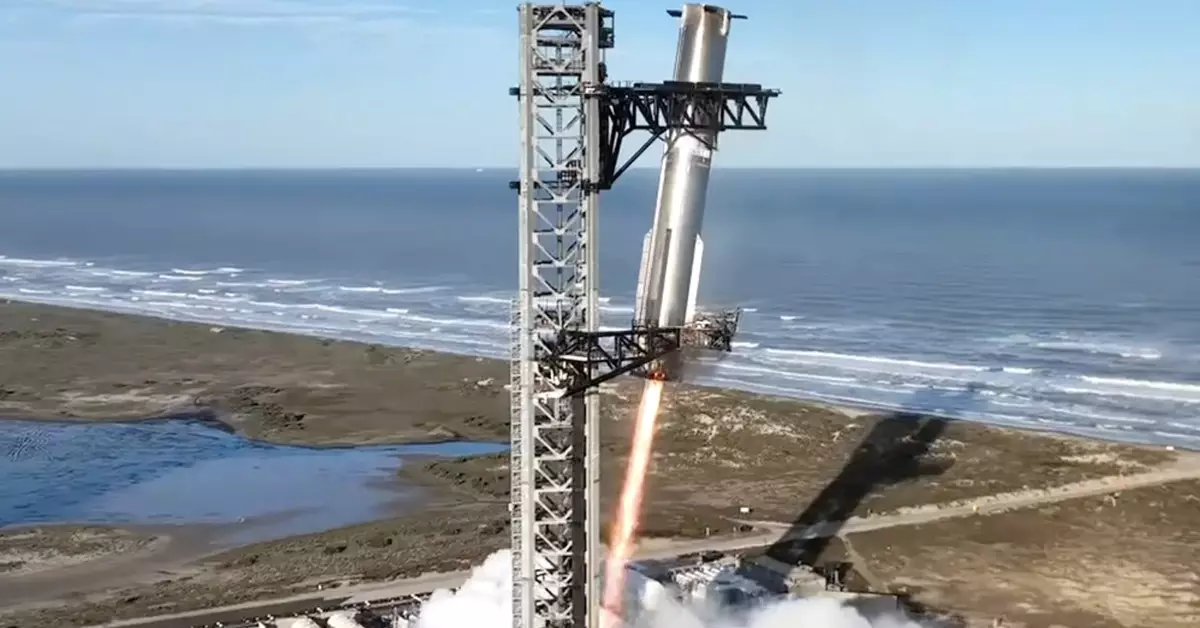SpaceX’s relentless pursuit of interplanetary travel and reusability recently culminated in another significant milestone with the seventh test flight of its eagerly anticipated Starship. On this occasion, the focus was not just on the mighty spacecraft itself but also on the Super Heavy booster, which played an integral role in the mission. Standing tall at 403 feet, the Starship is not only the largest launch vehicle designed to date but also emblematic of SpaceX’s vision to redefine space exploration and commercial satellite deployment. The execution of a successful catch of the Super Heavy booster by the launch tower’s “chopstick” arms during descent represented a remarkable engineering achievement and a leap forward in the realm of rocket reusability.
However, this test was laden with challenges. While engineers celebrated the booster’s catch, a critical communication loss occurred with the Starship spacecraft soon after separation. This unfortunate development raises essential questions regarding the robustness of telecommunications systems during flight, particularly in an era where seamless connectivity has never been more paramount in aviation.
SpaceX representatives confirmed that although the Starship successfully separated from the Super Heavy booster, it faced a rapidly escalating crisis during its ascent phase. Notably, a few engines reportedly malfunctioned, leading to a loss of telemetry and a resultant assumption that the vehicle was lost. As Kate Tice from SpaceX confirmed during a live stream, this type of failure—characterized as a “rapid unscheduled disassembly”—illustrates the unpredictable challenges engineers must grapple with during test flights. This incident highlights a crucial reality of aerospace engineering: even well-laid plans can falter mid-execution, inevitably complicating the lifecycle of such ambitious projects.
The loss of communication raises vital questions regarding redundancy and resilience in spacecraft systems. Given that these vehicles are anticipated to support demanding missions in the future, the lessons gleaned from this incident could prove invaluable in enhancing the reliability of SpaceX’s designs.
Despite the setback with Starship, several advancements were demonstrated throughout the flight, showcasing SpaceX’s commitment to continual evolution. This particular iteration of Starship boasted several enhancements aimed at improving the reliability and performance metrics of future missions. The updated propulsion system, coupled with an advanced flight computer, may serve as a robust foundation for future flights. Furthermore, the nascent testing of a new heat shield comprised of multiple metallic tile options—some equipped with active cooling technology—underscores SpaceX’s experimental ethos, propelling the narrative of innovation forward.
Interestingly, the decision to remove a substantial number of tiles from the upper stage was undertaken to stress-test potential vulnerabilities. While it remains unclear if this decision linked to the ultimate failure of the spacecraft, the willingness to experiment with various materials is a proactive strategy, suggesting that SpaceX seeks to identify weaknesses ahead of critical missions.
Public interest in SpaceX and its missions has steadily increased, fueled in part by social media exchanges and real-time updates from those situated near flight sites. Residents of Turks and Caicos shared videos of debris from the spacecraft’s re-entry, underscoring the broadening influence of citizen journalism in the space industry. The viewing of such events underscores an expanding communal engagement with space exploration, making these moments accessible in ways previously unimagined.
In addition to the technological advancements, the plan to deploy 10 Starlink “simulators” marked a pioneering effort to broaden the testing envelope. Even though these mock satellites were not intended for orbital longevity, the attempt indicates a significant step towards the operational demands of deploying actual Starlink satellites.
While SpaceX’s seventh test flight of Starship did not proceed entirely according to plan, the event was filled with both achievement and learning opportunities. The successful catch of the Super Heavy booster demonstrated significant progress in reusable technology, while the challenges faced during and after the flight highlighted the unpredictable nature of aerospace endeavors. As SpaceX assimilates the lessons learned and refines its systems, the foundation is solidly set for the next phase in the evolution of space travel. With each test, SpaceX inches closer to fulfilling its vision for humanity’s future in space, forging ahead through adversity and innovation.

